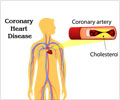A new imaging technology may hold the key to not only stopping heart attacks in their tracks but also preventing them for ever occurring.
A new imaging technology may hold the key to not only stopping heart attacks in their tracks but also preventing them for ever occurring. Researchers at Mount Sinai School of Medicine have shown the use computed tomography (CT) imaging along with a novel contrast agent know as N1177 can detect dangerous, high-risk plaque which cause heart attack and stroke. The findings may help physicians diagnosis a heart attack before the attack occurs.
High-risk plaque is characterized by their cellular and biologic structure. High-risk plaque rich in macrophages or cells can rupture, eventually causing a heart attack or stroke. Early identification of high-risk plaque in coronary arteries may be useful to prevent cardiac events but one major hurdle in detecting high-risk plaque is the lack of an imaging modality that allows physicians to see the composition of dangerous plaque, explains study author Zahi A. Fayad, PhD, FAHA, FACC, Professor of Radiology and Medicine (Cardiology) and director of the Translational and Molecular Imaging Institute at Mount Sinai School of Medicine. “Coronary CT imaging has advanced the diagnosis and prognosis of heart disease,” says Dr. Fayad. “But, what if we had the opportunity to prevent a heart attack from happening? This modality may allow us to do just that.”A team of researchers led by Dr. Fayad tested an iodinated nanoparticulate contrast agent called N1177 for the detection of macrophages in an animal model with 64-slice CT. High-risk plaque in this animal model contained high levels of macrophages which are similar in size and content to human coronary plaques. Researchers compared the enhancement of macrophage rich plaque after the injection of N1177 and a conventional CT contrast agent. The enhancement of the macrophage rich plaque after the injection of N1177 was significantly higher and specific inside of the vessel wall than after injecting the conventional CT contrast agent.
“We were amazed at these results. The introduction of N1177 allows us for the first time to look directly at the coronary arteries and pinpoint these dangerous, heart attack causing plaque,” said Dr. Fayad.
“N1177 had successfully progressed through Phase 1 clinical trials for use as a cancer staging agent,” said Don Skerrett, chief executive officer of NanoScan Imaging, LLC, and provider of N1177. “The unique properties of N1177 make it a versatile agent with a range of applications including: intravenous administration for the assessment of atherosclerosis and identification of vulnerable plaque, inhalation delivery for improved lung cancer staging and subcutaneous delivery for assessing cancerous extension into lymph nodes.”
The Mount Sinai researchers also believe this development may have broader clinical implication.
“N1177-enhanced CT will be helpful for diagnosis and prognosis of disease states. In the future, this technology may allow for the targeting of macrophages to specifically dispense therapeutic agents to disease tissue.”
Advertisement
SRM











